Late Date, Zen Journey to the Great Path Mountain

The Da Jing Mountain in Yuhang, Hangzhou, Zhejiang Province is known in the writings of the Song Dynasty literary giant Su Dongpo as "the peaks come from Tianmu Mountain, with a momentum like a galloping horse rushing towards the plain.",
This is also a place that has been immersed in the millennium old Zen tea culture.

What makes Jingshan famous all over the world is Jingshan tea. Jingshan Tea, also known as Jingshan Maofeng, is on par with "West Lake Longjing". It is said that during the Tang Dynasty, Lu Yu wrote a book called "The Classic of Tea" here, which fully demonstrates the significant position of Jingshan tea in the Chinese tea industry.

Here is the first of the five major Zen temples in Jiangnan - Jingshan Temple
This ancient temple, which originated in the Tang Dynasty, has witnessed the rise and fall of Chinese tea after experiencing prosperity and loneliness.

The reason for this trip, in short, was to escape the heat and cool down. However, my friend was busy with official duties and procrastinated time and time again. As a result, the original summer vacation coincidentally turned into an upgraded version of a tea tasting meditation trip, which is now a kind of fate.

If it weren't for the recommendation of my friend, I would have never expected that the destination of this trip to the suburbs of Hangzhou would be the origin of Japanese matcha and tea ceremony. It can be understood as Jingshan Zen Tea, which is now the ancestor of the legitimate red matcha. Therefore, Jingshan Tea is also known as "Zen Tea".
Regarding the itinerary:

Since it is said to be a journey of tea tasting and meditation, it will also be a temporary adjustment for pure mountain and water sightseeing, for your reference only.
Day1 Shanghai Hangzhou Dajingshan
Morning: Departing from the Dajingshan Tourist Distribution Center - Visit the Jingshan Ancient Road
Afternoon: Tea Culture Experience at Dajing Mountain - Tour of Jingshan Flower Sea
Dinner: Shuangjing Road Food Street, Dajingshan
Hotel: Stay at Luyu Junlan Resort Hotel
Day2 Luyu Junlan Resort Hotel - Dajingshan - Shangougou - Hangzhou
Morning: Da Jing Shan - Yun Lai Ji Homestay Visiting Tea - Making Inheritors - Jing Shan Temple
Lunch: Shuangjing Road Food Street, Dajingshan
Afternoon: Shangougou Maotang glass walkway Tangkeng
Regarding transportation:

In addition to being able to self drive through navigation, there is a bus route 586 directly from Hangzhou that can reach the scenic area, which is really a great benefit for tourists who come to admire it.
The route 586 starts from Jingshan Temple, passes through Changjing Line, Provincial Road 15, Nanhu Road, Chengxi Road, Fengxin Road, Yuhang Road, Tianmu Shanxi Road, Tianmu Mountain Road, Baochu Road, Tiyu Road, Yan'an Road, Qingchun Road, Wulin Road, and ends at Liugong Park.
Departure time: 7:20, 12:20, 13:20 at Jingshan Temple; Six parks at 8:40, 9:40, and 15:40. Departure time for interval scheduled trains: 6:00 from Yuhang to Jingshan Temple, and 17:30 from Jingshan Temple to Yuhang; 7:20 from Yuhang to Liuyuan, and 14:40 from Liuyuan to Yuhang.
The ticket price is 8 yuan per person on a one ticket basis, and a regular IC card can be used for boarding.
Regarding accommodation:
Luyu Junlan Resort Hotel
https://hotels.ctrip.com/hotel/435447.html

In fact, taking the entire Dajing Mountain as an example, there are countless homestays and inns that can provide accommodation, making it easy to get dizzy. So why do I still recommend the one mentioned?

In fact, compared to the increasingly popular homestays in recent years, staying at the Luyu Junlan Resort Hotel is the best way to experience the culture of Jingshan tea.



The hotel was designed by a renowned landscape architecture designer from the Chinese Academy of Fine Arts. From the beginning of the design, he integrated the concept of "tea culture" into it. The lobby with Chinese elements is simple and elegant, and the unique tea culture corridor quietly tells the history of "Tea Saint".


The decoration and layout seen along the way through the lobby, ranging from a room door sign named after various tea leaves to the design and decoration of the entire room, all embody the designer's clever ideas and "Lu Yuren"'s attention to the details of "tea" culture.

All items in the room have also been carefully designed and selected by the designer, including specially customized carpets, tea culture background walls, and guest room soft decorations, all reflecting a unique heritage and elegance.


The picturesque outdoor corridor and semi outdoor restaurant can give people a sense of peace and distance. As a nearly spiritual journey, choosing to stay here is definitely the right place. A room with a minimum housing price of over 400 yuan has even higher cost-effectiveness.
Tips:
At present, the hotel is participating in a joint discount with scenic spots. You can enjoy a double vacation of Hangzhou Suburban Zen Tea at 588 yuan. The package includes
Admission to the scenic area (ancient hiking+tea ordering experience+meditation experience+Jingshan Flower Sea), and also includes one night at the Luyu Junlan Hotel (including breakfast for two)
Dajingshan Tourism Distribution Center
Address: No. 6 Zhuhai Road
This is a tourist service center that is more like a scenic spot than a tourist attraction.

The long lost trip made our group chat happily. Starting from Hangzhou East and taking the highway, it took about 50 minutes to reach the Jingshan Tourism Distribution Center in front of us.

The Dajingshan Tourism Distribution Center has four floors: the first and second underground floors are underground parking garages, equipped with tourist rest halls, transfer stations for tourist buses and small buses, and organized three-dimensional transportation to achieve seamless connection between internal and external transportation; The ground floor serves as a tourist consultation service center and reception center; The second floor is mainly used as office space for the distribution center.


At least I have seen some people in the market before, but the grandeur and grandeur of the tourism distribution center in Dajingshan have indeed overturned my impression of a traditional distribution center. Walking into the hall is even more insightful. It is said that the CCTV documentary "The Story of a Leaf" was filmed here, which is truly extraordinary.
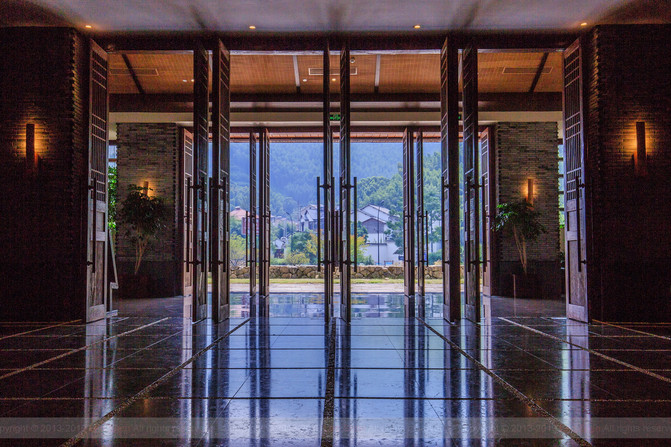
Not only can you get a lot of information about Jingshan tourism here, but you can also enjoy a unique tea ceremony performance, and it is also the starting point for Jingshan's unique hiking, cycling, and self driving tour routes.

Since you can not only enjoy the unique rural scenery here, but also experience the Zen and tea culture of Jingshan, as well as the delicacy and Zen spirit here. We cannot miss out on coming from afar.

Meditation, meditation, and copying of scriptures. You can feel the calm and joy of "sitting is also meditation, walking is also meditation".


Before meditation, one needs to change clothes, clean hands, and incense. It has to be said that the same meditation experience is done here with considerable quality.



The process of washing and incense feels a bit similar to simulating bathing and fasting. Perhaps according to the formal tea ceremony etiquette, participants in meditation should indeed have a more complete process. However, because the current arrangement for tourists is only for experience, everything is already simplified.


The significance of meditation is more about freeing oneself, soothing emotions, and preparing oneself mentally for the subsequent copying of scriptures.


Tasting a cup of Jingshan tea, which is unique to Jingshan, has a significant effect on relieving life stress.


Copying scriptures and worshiping Buddha is all about following fate. Copying more or less is a personal decision. As the saying goes, sincerity leads to spirituality. However, in fact, the one hour experience is a significant psychological and physical exercise, and it is even more difficult for us who usually have the opportunity to write without leaving our hands.

Tea ordering experience

Don't underestimate this display, as you can see, the cultural experience of Jingshan Diancha in front of you is the origin of world matcha.
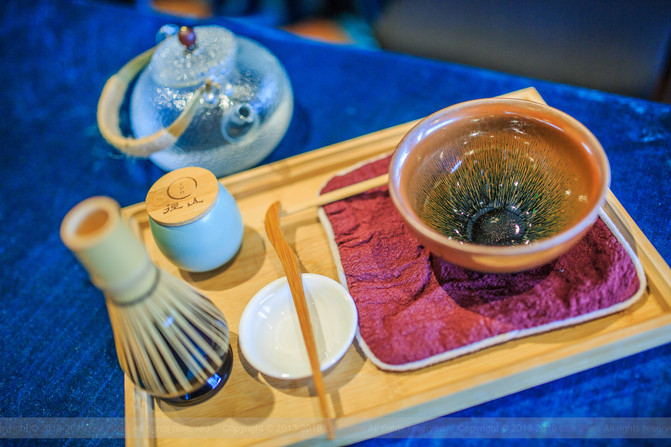

The service center provides each user with the same equipment as the demonstration teacher, which means that if operated normally, everyone has a full chance to make a decent matcha.



In order to save time, the process of making tea powder here is only for demonstration, just to tell everyone that each step is manually operated. If your tea is not good, it is largely due to personal proficiency.

In fact, I have been to Japan several times before and have always felt that Japan's tea ceremony skills are extensive and profound. However, today when I saw Jingshan ordering tea, I realized that the authentic source and process are indeed different. Of course, it has to be said that Japan has further improved and upgraded the techniques and processes of matcha, which is why most people think that matcha is a type of Japanese tea. In fact, you should understand now that the ancestors of matcha are actually located in the Dacheng Mountain of Yuhang.




As for whether it is possible to make a decent matcha, not only does it require a certain amount of heat, water temperature, speed, and the tea itself to be carefully crafted, but with some hesitation or inadequacy, the resulting tea will not only lack fragrance but also be very light. Speaking of which, I also think that Japanese matcha is really very bitter and has a strong taste.

Tea characters, people in the grass and trees.
This is the shape of tea and also the imagery of Zen.

The last Chinese word for tea also elevates the entire process of ordering tea, and sometimes tasting tea is also an attitude towards life.

If you are interested in making matcha, Jingshan Tourism Center sells a complete set of professional equipment, allowing you to grind and experiment at home, which is quite interesting.
Jingshan Flower Sea
Address: No. 99 Longhuang Road, Jingshan Town, Yuhang District, Hangzhou City


"Jingshan Flower Sea" is located at the entrance of the core block of Dajingshan National Rural Park, adjacent to the Caoya Line to the south, Longhuang Avenue to the east, and Tiao Creek to the north. The overall planning of the project covers an area of 3000 acres, with the first phase covering 1000 acres. It is said to be the gateway project of the starting point of Dajingshan Tourism Area. Dazhi took a look at the entrance and found that the scale is indeed quite large.




Every spring and autumn, during the flowering season, dozens of flowers such as high snow wheels, blue mustard, Yu Meiren, and goldfish grass compete to bloom in the garden, making it a sea of flowers, known as the Jingshan Flower Sea.


Sitting on the small train in the park allows you to experience the ease of leisurely sightseeing, taking photos and admiring flowers.
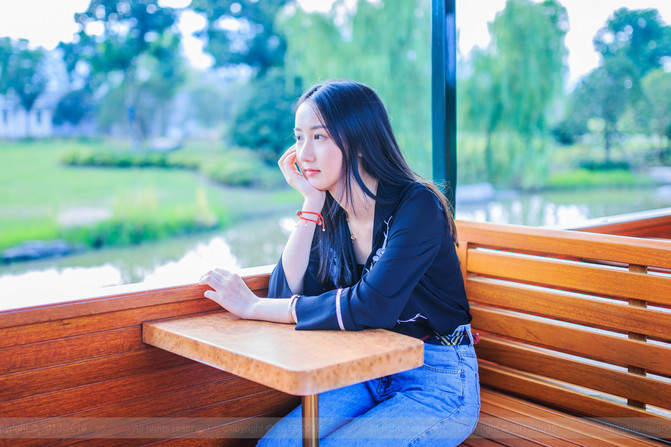

Although the best viewing period for lotus flowers has been missed so far, the water lilies in the pond are still blooming exceptionally enchantingly.


The unique geographical location and favorable natural conditions make it a home and habitat for many birds. The park has also specially built a complete home for a pair of black swans, which is also convenient for tourists to watch.


The air quality inside the scenic area is quite high, and there are still some scenic spots in the planning process. I believe that if the entire scenic area is fully opened, it will definitely be magnificent. As a signature attraction of Dajing Mountain, it should not be missed.


Dinner will be held at the Food Street near Zhuhai Road and Shuangjing Road, where many well-known farmhouse dishes from Dajing Mountain are gathered. Personally, I feel that the dishes from each family are similar, and the difference in which restaurant to choose for dining is not significant. However, compared to farmhouses on the mountain or further mountain villages, the cost-effectiveness is quite high.


The signature Jingshan mixed fish, homemade tofu, white shrimp, and screws have undergone simple processing and are indeed delicious. A good rural meal can be enjoyed with an average consumption of about 80 yuan per person.

Specially recommended, you can taste the wild frog on the mountain. Its meat is quite plump and chewy. Although it cannot compare to the size and meat of bullfrogs, it is already very special as a farmhouse dish.
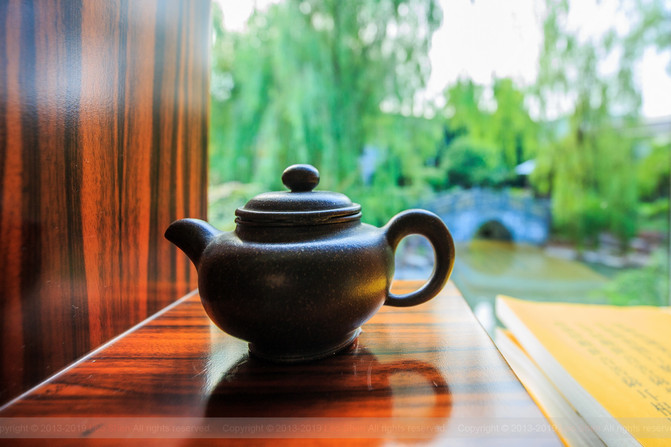
Returning to the hotel, just before the sun had set, I brewed a pot of Jingshan tea and wandered through the garden like courtyard of the hotel, which was a kind of elegance. It seemed that I had regained some of my original intentions at this moment, and finally, I had a chance to relax and feel the tranquility of time.

The next day, Jingshan Temple encountered a "danger" in a mountain ditch and edge seeking mountain


The next day at dawn, I wanted to climb the mountain early while the sun was still shining, to experience the ancient hiking route and the ancient path of Jingshan. It's just that human calculations are not as good as natural calculations. When the car reached halfway up the mountain and encountered a temporary road repair, it had to stop at an inn on the roadside for a while to take shelter. Unexpectedly, it ended up encountering a benefactor.

In the Yun Lai Ji Inn, there is a hidden expert. When the landlady learned the reason for our self driving trip, she warmly recommended that since we have already experienced the tea ordering in Da Jing Shan, we must not be unfamiliar with an important tool in tea ordering - tea. Coincidentally, the inheritor of Jing Shan Town's handmade tea making happened to be at her inn. We can also take a break and observe the master's creative process.

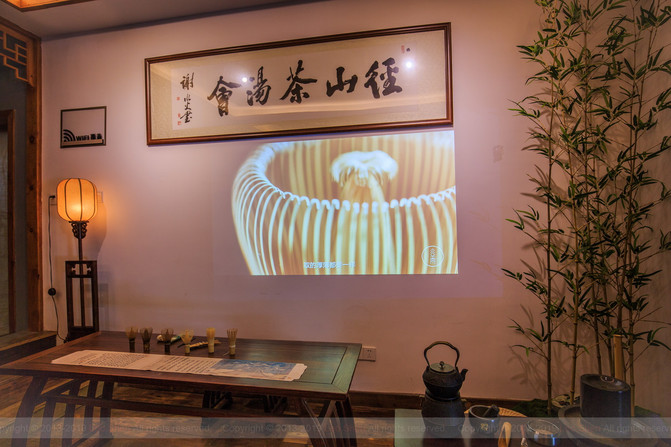
Listening is believing, seeing is believing. In the tea room, there is a promotional video of the master making tea that has been filmed before. After watching it, we are even more looking forward to the appearance of the protagonist, Teacher Chen Jinxin.

Teacher Chen, who often participates in lectures and demonstrations, learned about our origins and enthusiastically introduced that the fundamental origin of the tea we see so far is in China. In the Northern Song Dynasty, the method of ordering tea was popular, and tea taste was also an important tea utensil for ordering tea. It was a great improvement of tea ordering tools and an important sign that the method of ordering tea reached its peak in the Northern Song Dynasty by brushing Noodles in soup with tea and water. After entering the Ming Dynasty, the habit of Chinese people drinking tea underwent a huge change, and tea gradually disappeared.

After the introduction of Diancha from Jingshan to Japan, Japanese tea enthusiasts continuously improved and their production techniques became increasingly sophisticated, forming unique tea making techniques and standards. When the number of students surpassed the teacher, such a thing happened to Tea, and a history of tea was interrupted.

Subsequently, the teacher also personally selected materials to demonstrate on site how to handcraft one of the most important tools in making tea, the tea pot.
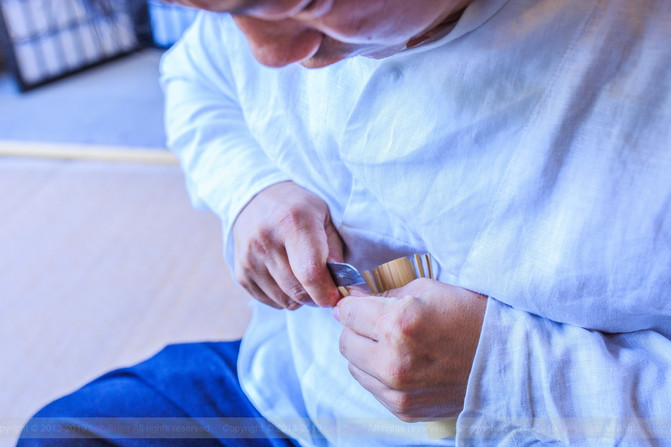

The production of tea involves a combination of professional craftsmanship and traditional bamboo weaving, which involves 18 processes including material selection, wire punching, scraping, bending, and finishing. The most advanced stage of craftsmanship is the bamboo cutting process, which is facilitated by Teacher Chen's skilled craftsmanship, making the entire process flow smoothly and visually stunning.



With a small knife, cutting a bamboo strip into seventy-two outer spikes as thin as hair not only requires dexterity, but also tests the craftsman's experience and reflects their skills.


Actually, until the finished product appeared in front of me, I couldn't believe it was actually handmade. Today, I really gained a lot of knowledge by chance.
Jingshan Ancient Road
As a necessary route to Jingshan Temple, the Jingshan Ancient Road is very close to halfway up the mountain. I had planned to take advantage of the strength in the morning to climb to the top in one breath
Visiting Jingshan Temple has been delayed due to some accidents, so since I came, I can't come for free. So I took a short walk along this millennium old road, and actually felt a lot.

The Jingshan Ancient Road, with a total length of 2.8 kilometers, has a profound cultural history and is a unique natural tourism resource of Jingshan. In ancient times, Jingshan Ancient Road was not only an important transportation artery, but also a cultural artery. It is through it that the Zen tea culture of Jingshan has gone global.

It takes about 2-3 hours to walk the entire distance. Due to time constraints, we won't experience the entire journey today. We will do the full experience again when we come next time. However, mountaineering is still very popular for fitness purposes.
Jingshan Temple
Address: Jingshan, Jingshan Town, Yuhang

In fact, the first time I saw Jingshan Temple was in the promotional slides of the tourism distribution center. I didn't expect such a bustling temple to be hidden in such a lush mountain.

The car drove all the way to the top of the mountain. In the depths of the bamboo sea and tea mountains, lies an ancient and beautiful Zen temple.


As mentioned earlier, there are two ways to climb the mountain. The most convenient one is to take a free shuttle bus from the tourist distribution center within the scenic area; Tourists who want to hike can also take the Jingshan Ancient Road up the mountain at Tongqiao.
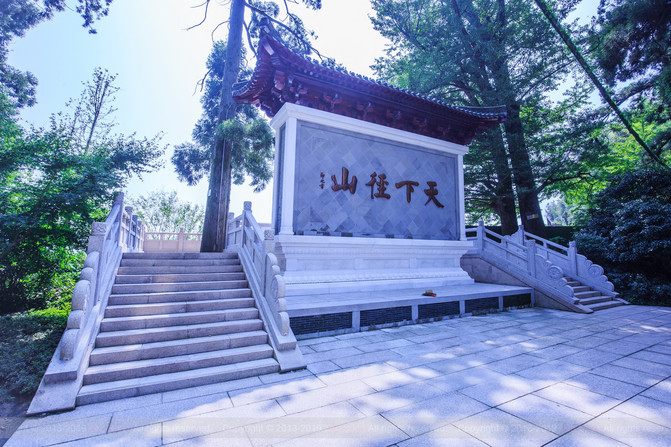

The reason why Jingshan Temple is so famous in history is also because, in addition to the Japanese monk Yuan'er Bianyuan, who introduced the tea banquet style of Jingshan Temple to Japan and evolved it into Japanese tea ceremony, he also introduced the vastness and profoundness of Chinese Buddhism to Japan.
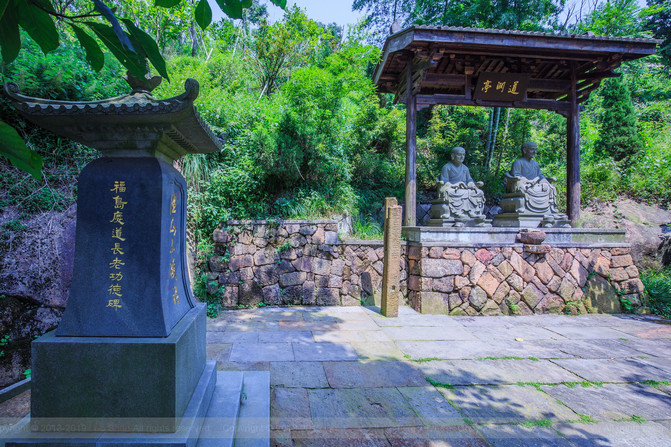
In 1235, it was also a day of fragrant spring tea. Japanese Zen master Yuan'er discerned the circle and walked into Jingshan with a devout heart. He studied Zen at Jingshan for three years. Then, I returned to Japan and brought back the Zen teachings and tea ceremony of Jingshan. Later on, in terms of tea utensils and etiquette, Japan's tea ceremony fully inherited the tea ceremony of the Song Dynasty Zen Temple. The two sculptures and stone tablets on the left side of the entrance of Jingshan Temple were built to commemorate the entire event.

Jingshan Temple is the ancestral temple of Linji Sect. During the Southern Song Dynasty, it was known as the "Number One Zen Temple in the Southeast" and ranked first among the "Five Mountains and Ten Temples" in Jiangnan.
In the second year of the Qiandao reign of the Southern Song Dynasty (1166), Emperor Xiaozong visited Jingshan and personally wrote a 5-meter-high stone tablet titled "Xingsheng Wanshou Zen Temple on Jingshan". There was also a stone imperial stele pavilion, and after the renovation of Jingshan Temple was completed, there should be an opportunity to open it to the public for sightseeing.


The temples have obviously been renovated in recent years, and later research has confirmed this. There are very few remaining Jingshan temples in history. Entering through the gate are the Temple of Heavenly Kings, the Shakya ManiHall, Sutra Pavilion and Guanyin Temple.

People can only search for history in the stone statues and stone tablets in front of their doors. And this has not affected the status and weight of Jingshan Temple in the hearts of pilgrims at all.

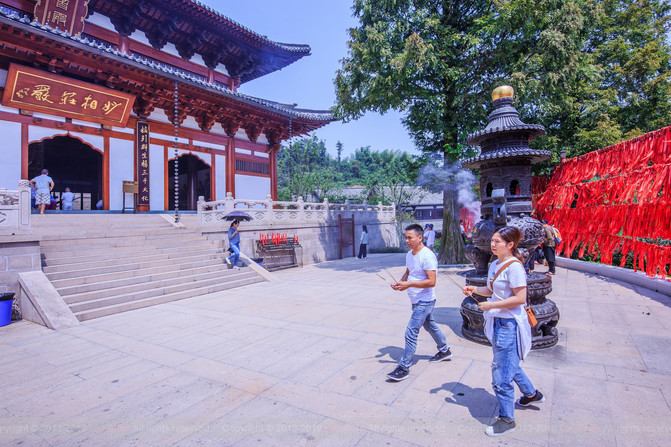
The rebuilt Jingshan Temple can be said to be completely transformed, sweeping away the slightly tacky appearance of traditional temples in China and adopting a rare Song Dynasty architectural style, solemn and rustic. At present, there is still a continuous stream of incense every day.


Jingshan Temple has always been famous for its picturesque mountains, beautiful water, and fragrant tea. It is the inheritor of the "Jingshan Tea Banquet" national intangible cultural heritage project. Regular Zen tea ceremonies are held at Jingshan Temple. If you are fortunate enough to participate, using the tea ceremony and spreading tea through the Tao, you will have the opportunity to purify your body and mind~

Hungry all the way down the mountain from the temple, I still chose to have lunch near the bustling Zhuhai Road for convenience and speed. In order to save time, I tried to keep everything simple.



The semi-finished ingredients, combined with the boss's skilled skills, make the speed of serving dishes truly worthy of our choice.

The ravine
Luniao Town, located 40 kilometers northwest of Hangzhou

On the way to the mountain ditch, you will pass by a beautiful lake, whose prototype is the Siling Reservoir, now known as Jingshan Lake. A 44.5-meter dam condenses into a top-quality jade. Jingshan Lake is shimmering with the light of the lake, and the mountain scenery is exceptionally beautiful. The lakeshore is winding and winding; Gradually deepening and fading into the surrounding green mountains.

Shangou Gou is not simply an adjective, but a general term for a scenic area that encompasses various styles such as tourism, leisure, and vacation.

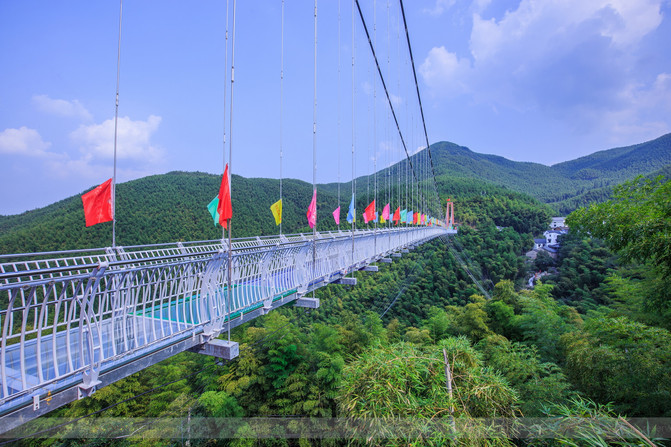
At present, the glass walkway is one of the special scenic spots with the highest open exposure rate in China. It is basically to build a fire. The gully, the glass walkway built later, is more mature and safe.

The heart-shaped wall beside the ticket window is also suitable for couples to take photos. Of course, the completely transparent glass walkway is also a small skill to test the feelings of each other. Ha ha, I remember seeing many people who look presentable at ordinary times. As a result, once on the platform, the whole people were surrounded, and finally there were many people lying on their stomach...


The middle point of the suspension bridge is very loose, and the curved structure allows you to easily choose the best angle to take photos of yourself.


From trembling at the beginning to casually sitting on the ground and taking photos, mindset and cognition are really important. Whether this project is really scary or not, I think only personal experience can have a say.


If this glass walkway is on foot, you can directly choose the opposite bank to get off and continue to visit the scenic spots.

Tangkeng is a place name because most local people have the surname Tang, and many small place names in the area basically have the word "keng", so it is also called Tangkeng. The entrance of the scenic area is also very unique, with two ditches on the side of the large "mountain" shape, which corresponds to the tourist place name of the mountain ditch.


Along the ancient road, there are 18 waterfalls of various sizes, with murmuring waterfalls and flowing springs, known as the "18 Waterfalls in a row". It is said that the average temperature here is about 10 degrees lower than outside the scenic area, making it a popular summer resort. In my personal opinion, it is not that exaggerated, but it is true that there is a lot of coolness in the mountains.

The bamboo raft between the waterfalls can be a great experience for tourists, but it is recommended to try it out for those with a lighter and thinner body shape. Otherwise, the bamboo raft will have too deep draft and it is easy to get your shoes wet. When you come out to play, happiness is important, and safety is more important.
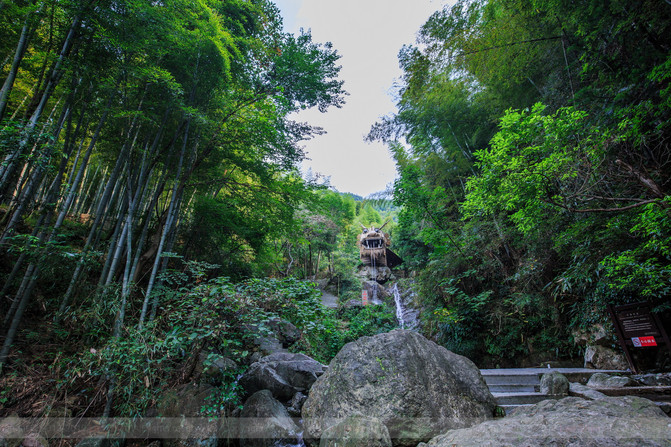

At the end of the waterfall is a dragon head waterfall, and behind the dragon head is the dragon body, which is a long corridor. It is reported that this long dragon is also known as the "Number One Bamboo Long Dragon in China". It is made entirely of bamboo and was originally exquisitely crafted to welcome the "2008 Beijing Olympics". The dragon head starts from "Cuiping Welcoming Guests" and ends at "Meihua Mountain Lane". Zhulong has a total length of 208 meters, which was the longest in China at that time. Looking around, the entire long dragon lay still in the canyon, winding and lifelike.

On the way up the mountain, there were waterfalls and pools of all sizes, and there were also many pictorial stones to be seen. As for whether the legend was true or not, I think it can only be understood but not expressed in words.
One side of the tea garden


On the way back to the tourist distribution center from the mountain, you will also pass by a tea garden, which is the proud location of Jingshan Tea in Jingshan Town. Although it has been going back and forth for several days, there is not much time to stop and enjoy it. The tea garden and distant mountains appear even more beautiful in the sunset.



Smelling the fragrance of the tea garden, the brief two-day self driving trip to Da Jing Shan can be considered as an end. Although there were some regrets and shortcomings, fortunately, it was also considered to have saved the danger and benefited from misfortune. Each trip may not really be for what you see, leaving some memories and memories is the true meaning of travel.

Postscript

Facing the upcoming Golden Week, if you also want to take a different path and experience a Zen journey, then climbing the ancient path of Dajing Mountain, following the footsteps of a thousand year Zen tour, and experiencing the revival of the ancient tea ceremony will definitely not disappoint you.
The limited edition discount packages currently offered by scenic spots are also very affordable. If you are interested, you can try them out.
Hangjiao Zen Tea Double Vacation: Ancient Road Mountaineering+Tea Pointing Experience+Meditation Experience+Jingshan Flower Sea+Luyu Junlan Hotel
The package needs to be used before November 30, 2019, and hotel accommodation needs to be booked three days in advance by phone.
I am @ Shanghai Cold Air. Every time we meet, it's like meeting for the first time. I look forward to the opportunity to meet you on our next trip. Thank you.
Previous Article:How beautiful is Jiangnan during the rainy season? Why not come to Hangzhou for a relaxing trip and enjoy the misty and rainy scenery of Jiangnan
Next Article:Watch the sea in Qingdao, enjoy the spring in Jinan, and enjoy the cool summer!
